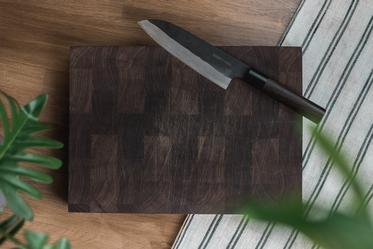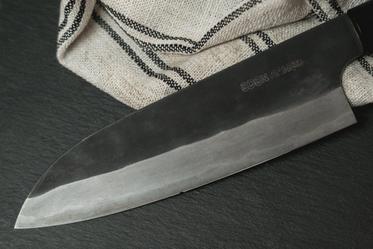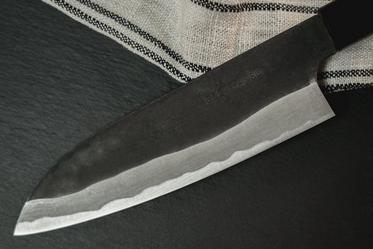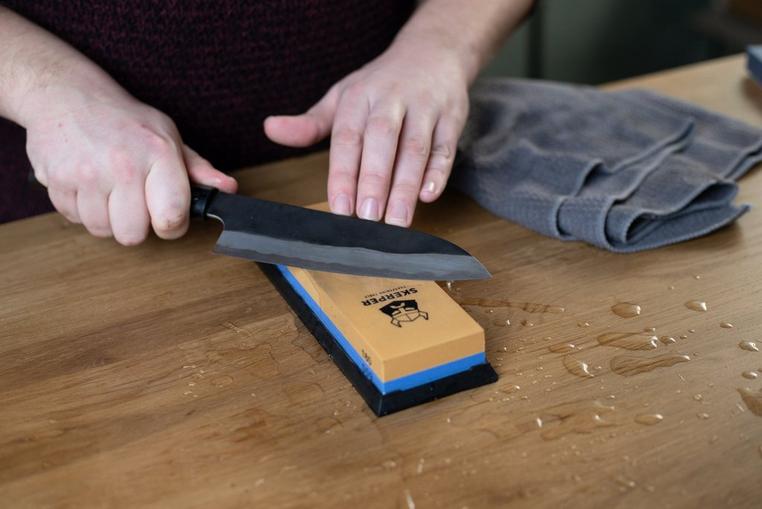How do you remove a chip from the edge of your knife?
Customers often ask us about chipped knives. When we're talking about a chip in a knife, we're not talking about a little transmitter to track your knife, nor are we talking about a salty snack. Chips are little nicks on the edge of the blade. This damage will cause the edge of your knife to become blunt.
A chipped knife can happen to anyone. It could happen, for example, by accidentally cutting into a piece of bone when using the wrong cutting technique. Mistakes are easily made. You can avoid a lot of trouble by simply using your knife carefully. However, if your knife still ends up with a chipped edge, it is often possible to solve this problem yourself. How? You will learn more about it by reading this article and by clicking on the video!
What can cause a chipped edge?
9 out of 10 times, a chip is caused by careless use of your knives. You're more likely to see chips in thin, often Japanese knives, because these are usually sharpened at a small angle and made of a hard steel. Of course, this doesn't mean that you should avoid these knives. Thanks to their hard steel, these knives provide a cutting performance that is almost impossible to achieve with a western knife.
Better safe than sorry! To reduce the chance of a chipped knife, you'll need to know what causes chipping, so you can avoid it as much as possible. There are several things that can cause chipping, but the common denominator? Improper use of your knives.
Using cutting boards that are too hard
It is of the utmost importance to avoid granite, marble and glass cutting boards. Admittedly, they look great, but they wreak havoc on your kitchen knives. This is because these materials are harder than the hardest types of steel. The best case scenario is that your edge bends or becomes dull. But if you're unlucky, some pieces will break off and a sort of micro-serration will appear. You don't want this to happen!
This is why you should always go for a wooden or plastic cutting board. These are a lot more forgiving. Another thing to keep in mind is that you should use your kitchen knives in the way they are intended to be used. Usually, they are meant for cutting. Not chopping. With most kitchen knives, you should aim to keep the tip of the knife connected to the cutting board while you're cutting. This ensures that the knife can do its job, and you don't have to apply brute force. Do you want to break apart bones? Or a frozen piece of meat? Please use a chopping knife.
The correct cutting techniques
The chance of chipping is obviously a lot higher with pocket knives or outdoor knives than with kitchen knives. You are using them 'in the wild' to cut countless different materials. It's conceivable that you could accidentally come across a stone subsurface or come into contact with metal.
This is not usually the case with kitchen knives. You can 'safely' use them in the kitchen, and you can prevent most chipping by cutting the right ingredients on the right surface. In addition, the right cutting technique is very important for kitchen knives.
Kitchen knives are called kitchen knives for a reason. Kitchen knives are made for cutting delicate products such as fruits, vegetables, meat and herbs. They are not meant to be used for the opening of (plastic) packaging or cans, or for moving cut items across the cutting board. If you want to do the latter, make sure to use the spine (back) of the knife, not the edge.
How do you repair a chipped edge? Use a coarse sharpening stone
Sometimes chips are clearly visible, but in most cases you don't really see them with the naked eye. However, you will inevitably notice them during use, as your knife will snag at a certain spot. If this is the case, there's no reason to panic. You don't need to throw out your knife. In most cases it's even possible to repair your knife yourself!
When is a knife too badly damaged? In our experience, a chip bigger than 2 mm is too big to repair yourself. You would have to remove a lot of material, and it would not be a realistic option to sharpen the knife. In this case, please contact us or a professional knife sharpener.
In essence, you scrape away a thin layer of material until the chip is gone and the edge is nice and straight again. It is important to remove the same amount of material over the entire edge of the knife. After all, you want to maintain the profile (the shape of the blade) as much as possible. Removing a relatively large amount of material is unavoidable.
Start with a coarse sharpening tool. These are durable and quickly remove a thin layer of steel. It is best to use a diamond or ceramic sharpening stone with a low grit size. Definitely nothing higher than 200 grit. Check out all our extra coarse sharpening stones! After the chip has been removed, you will re-sharpen the edge with finer sharpening tools.
Sharpening
Whether you're using sharpening stones, a file or a sharpening system: you might have the urge to place the edge on the sharpening tool at a 90-degree angle. Don't do this, because the edge of your knife will take a U-shape instead of the V-shape that you want. You should try to avoid this U-shape, as it will cause the knife to become too thick 'behind' the edge, and it will be more difficult to sharpen it properly. You should sharpen the knife in the same way that you would usually sharpen the knife for maintenance.
Place the knife at the correct sharpening angle on the coarse sharpening stone and pull the knife over the stone several times. Make sure to regularly switch between the sides of the blade, and sharpen each side equally to keep the edge nice and even. When will you be done? When you can no longer feel or see the chip!
If you're using sharpening stones to remove the chip, we recommend using a slightly different technique than you're probably used to. You won't make a 'cutting' movement from heel to tip, but instead you'll make short up-and-down motions across the length of the blade. This allows you to remove more material faster.
Sharpening systems or sharpening machines with coarse sharpening stones or sharpening belts are also suitable. For example, the Work Sharp Ken Onion & Tool Sharpener.












